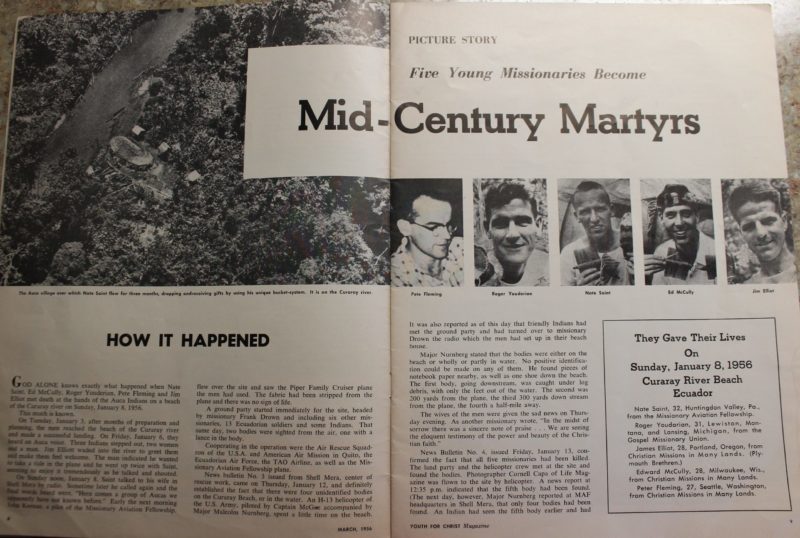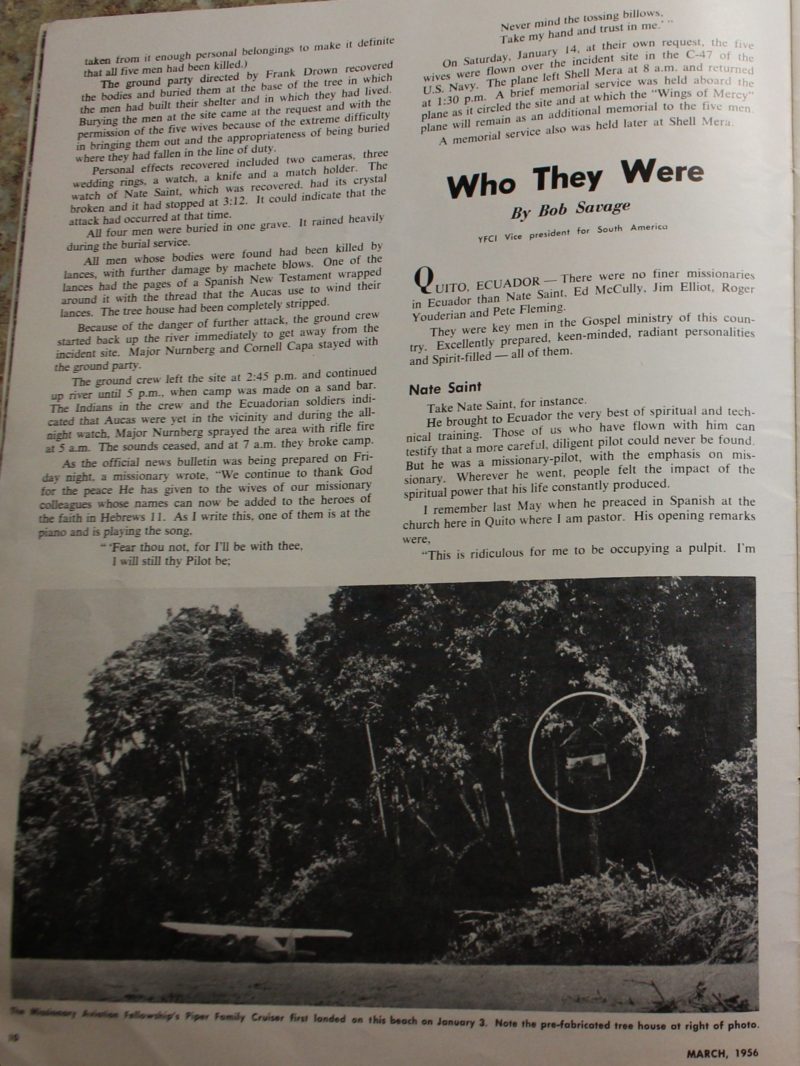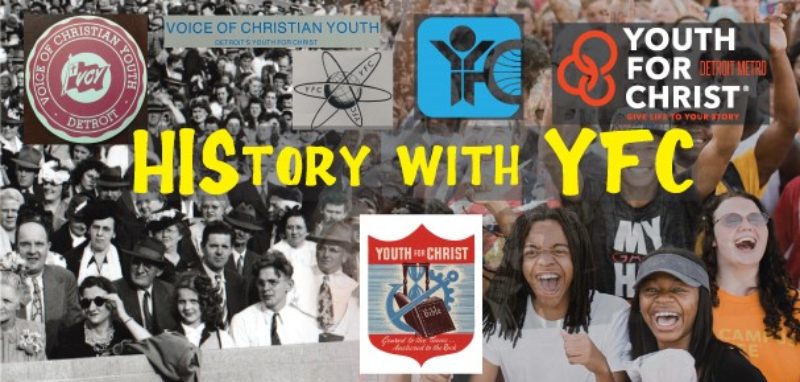Youth for Christ Magazine Vol XIII No. 12 March 1956
Modern day note:
Below is the first in a series of Articles about the Five Young Missionaries who became Martyrs. It is copied exactly as it was written for Youth for Christ Magazine and published less than 2 months after the events. The series covers very early details about the events as told by YFC staff. YFC is a missionary organization, and this hit close to home for many staff then, and a shock to most of the world. We will post more of the stories from this series over the coming months. We are grateful for some of our Alumni to share the history of YFC with us, which allow us to share these stories with you. If you have things from YFC History or Stories of how YFC has impacted, you or your family. Please contact us, we would love to hear your story. Now On with our first article.
Mid-Century Martyrs (Series of Articles; Story 1)
How it Happened
pages 8-10
“GOD ALONE knows exactly what happened when Nate Saint, Ed McCully, Roger Youderian, Pete Fleming and Jim Elliot met death at the hands of the Auca Indians on a beach of the Curaray river on Sunday, January 8, 1956.
This much is known.
On Tuesday, January 3, after months of preparation and planning, the men reached the beach of the Curaray river and made a successful landing. On Friday, January 6, they heard an Auca voice. Three Indians stepped out, two women and a man. Jim Elliot waded into the river to greet them and make them feel welcome. The man indicated he wanted to take a ride in the plane, and he went up twice with Saint, seeming to enjoy it tremendously as he talked and shouted.
On Sunday noon, January 8, Saint talked to his wife in Shell Mera by radio. Sometime later he called again and the final words heard were, “Here comes a group of Auca we apparently have not known before.” Early the next morning John Keenan, a pilot of the Missionary Aviation Fellowship, flew over the site and saw the Piper Family Cruiser plan the men had used. The fabric had been stripped from the plane and there was no sign of life.
A ground party started immediately for the site, headed by missionary Frank Drown and including six other missionaries, 13 Ecuadorian soldiers and some Indians. That same day, two bodies were sighted from the air, one with a lance in the body.
Cooperating in the operation were the Air Rescue squadron of the U.S.A. and American Air Mission in Quito, the Ecuadorian Air Force, and TAO Airline, as well as the Missionary Aviation Fellowship plane.
News bulletin No. 3 issued from Shell Mera, center of rescue work, came on Thursday, January 12, and definitely established the fact that there were four unidentified bodies on the Curaray Beach, or in the water. An H-13 helicopter of the U.S. Army, piloted by Captain McGee accompanied by Major Malcolm Nurnberg, spent a little time on the beach. It was also reported as of this day that friendly Indians had met the ground party and had turned over to missionary Drown the radio which the men had set up in their beach house.
Major Nurnberg stated that the bodies were either on the beach or wholly or partly in water. No positive identification could be made on any of them. He found pieces of notebook paper nearby, as well as one shoe down the beach. The first body, going downstream, was caught under log debris, with only the feet out of the water. The second was 200 yards from the plane, the third 300 yards down stream from the plane, the fourth a half-mile away.
The wives of the men were given the sad news on Thursday evening. As another missionary wrote, “In the midst of sorrow there was a sincere note of praise… We were seeing the eloquent testimony of the power and beauty of the Christian faith.”
News Bulletin No. 4, issued Friday, January 13, confirmed the fact that all five missionaries had been killed. The Land party and the helicopter crew met at the site and found the bodies. Photographer Cornell Capa of Life Magazine was flown to the site by helicopter. A news report at 12:35 p.m. indicated that the fifth body had been found. (The next day, however, Major Nurnberg reported at MAF headquarters in Shell Mera, that only four bodies had been found. An Indian had seen the fifth body earlier and had taken from it enough personal belongings to make it definite that all five men had been killed.)
The ground party directed by Frank Drown recovered the bodies and buried them at the base of the tree in which the men had built their shelter and in which they had lived. Burying the men at the site came at the request and with the permission of the five wives because of the extreme difficulty in bringing them out of the appropriateness of being buried where they had fallen in the line of duty.
Personal effects recovered included two cameras, three wedding rings, a watch, a knife and a match holder. The watch of Nate Saint, which was recovered, had its crystal broken and it had stopped at 3:12. It could indicate that the attack had occurred at that time.
All four men were buried in one grave. It rained heavily during the burial service.
All men whose bodies were found had been killed by lances, with further damage by machete blows. One of the lances had the pages of a Spanish New Testament wrapped around it with the thread that the Aucas used to wind their lances. The tree house had been completely stripped.
Because of the danger of further attack, the ground crew started back up the river immediately to get away from the incident site. Major Nurnberg and Cornell Capa stayed with the ground party.
The ground crew left the site at 2:45 p.m. and continued up river until 5 p.m., when camp was made on a sand bar. The Indians in the crew and the Ecuadorian soldiers indicated that Aucas were yet in the vicinity and during the all-night watch, Major Nurnberg sprayed the area with rifle fire at 5 a.m. The sounds ceased, and at 7 a.m. they broke camp.
As the official new bulletin was being prepared on Friday night, a missionary wrote, “We continue to thank God for the peace He has given to the wives of our missionary colleagues whose names can now be added to the heroes of the faith in Hebrews 11. As I write this, one of them is at the piano and is playing the song,
“ ‘Fear though not, for I’ll be with thee,
I will still they Pilot be;
Never mind the tossing billows,
Take my hand and trust in me.’ “
“On Saturday, January 14, at their own request, the five wives were flown over the incident site in the C-47 of the U.S. Navy. The plane left Shell Mera at 8 a.m. and returned at 1:30 p.m. A brief memorial service was held aboard the plan as it circled the site and at which the “Wings of Mercy” plane will remain as an additional memorial to the five men.
A memorial Service also was held later at Shell Mera.”


